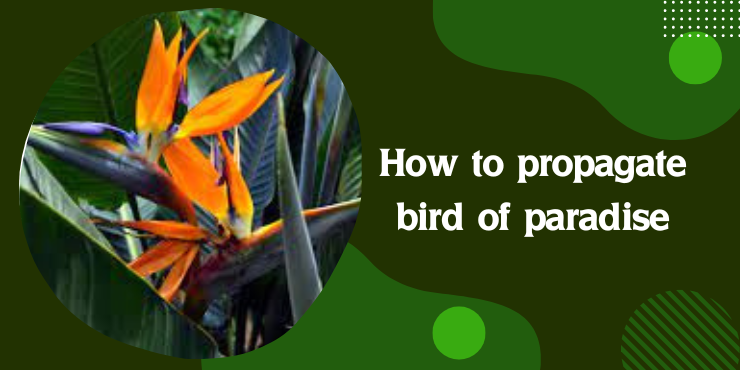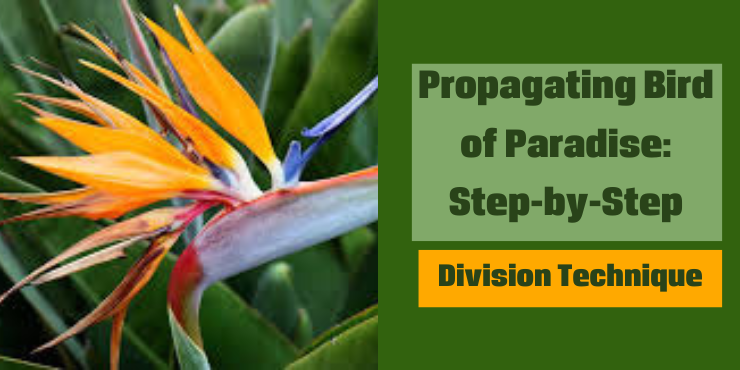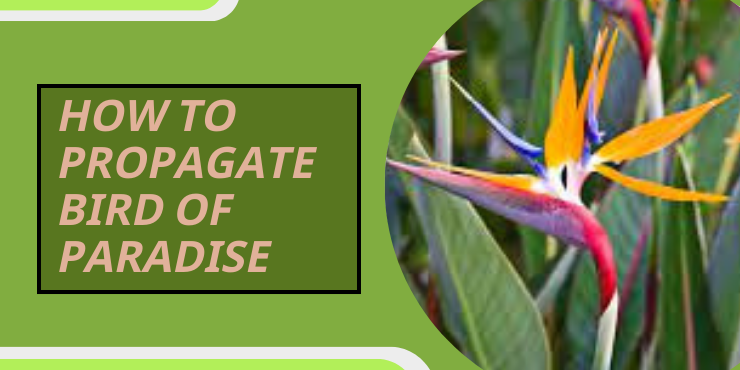How to propagate bird of paradise. How to Propagate Bird of Paradise Plants. With its vibrant and exotic flowers, is a stunning addition to any garden or indoor space. While they can be purchased as mature plants, many enthusiasts enjoy propagating these plants themselves. Not only is it a rewarding and cost-effective endeavor, but it also allows you to multiply your love for this fascinating plant.
In this guide, we will explore the various methods of propagating birds of paradise, including division, root cuttings, and seeds. Whether you are a seasoned gardener or a beginner, this comprehensive guide will equip you with the knowledge and step-by-step instructions to propagate your very own bird of paradise and watch it flourish in your garden. How to propagate bird of paradise. How to Propagate Bird of Paradise Plants. How to Propagate Bird of Paradise Plants.
How to propagate bird of paradise
How to propagate bird of paradise. Bird of Paradise (Strelitzia reginae) is a stunning tropical plant that can be propagated through several methods, including division, seeds, or offsets. Here, we will focus on how to propagate the bird of paradise through division. First, choose a healthy and mature bird of paradise plant to divide.
The plant should have multiple stems and a well-established root system. Spring or early summer is the best time to divide the plant, as it is actively growing. Start by removing the plant from its pot or carefully digging it up from the ground. Gently shake off any excess soil to expose the plant’s roots. Next, Locate any natural divisions or clusters of growth where stems emerge from the base of the plant.
Using a clean and sharp knife or gardening tool, separate these clusters into smaller sections. Each section should have a good number of stems and a portion of the root system. Trim any damaged or overgrown roots and remove any dead or yellowing leaves to prevent the divisions from expending unnecessary energy on them. Prepare new pots or planting holes for each division. Fill them with a well-draining potting mix that suits bird of paradise plants. Ideally, the mix should be loose and not waterlogged. A mix of peat moss, perlite, How to Propagate Bird of Paradise Plants.
Understanding Bird of Paradise Plant

How to propagate bird of paradise. The Bird of Paradise plant is a captivating and unique houseplant known for its vibrant and exotic appearance. With its striking flowers and feather-like foliage, it has become a popular choice among plant enthusiasts and homeowners alike. Whether you are a beginner or an experienced plant lover, understanding the Bird of Paradise plant will allow you to appreciate its beauty and successfully care for it.
In this guide, we will explore the fascinating characteristics of this plant, its natural habitat, and the essential tips and tricks for its maintenance. So, join us as we delve into the world of the Bird of Paradise plant and discover how to create a stunning tropical oasis in your own home. How to Propagate Bird of Paradise Plants
Propagation Methods
Division
How to propagate bird of paradise. The Bird of Paradise plant is a captivating and unique houseplant known for its vibrant and exotic appearance. It is a native of South Africa and is a member of the Strelitzia genus. This stunning plant gets its name from its flowers, which resemble the beak and feathers of a tropical bird, making it a popular choice for indoor gardens and tropical-themed landscapes.
The Bird of Paradise plant is a perennial plant that can grow up to six feet tall, with long, glossy green leaves that resemble the shape of a banana leaf. The plant produces clusters of large, orange and blue flowers that bloom from late spring through early fall. These stunning flowers are pollinated by birds, hence the name. There are various propagation methods for the Bird of Paradise plant, allowing plant enthusiasts to expand their collection or share this beautiful plant with others.
In this guide, we will explore the different methods of propagating the Bird of Paradise plant and provide essential tips and techniques to ensure successful propagation. Whether you are a beginner or an experienced plant lover, understanding the Bird of Paradise plant and its propagation methods will allow you to appreciate its beauty and enjoy the satisfaction of growing your own plants. So, join us as we delve into the world of this fascinating plant and discover the secrets to propagating the. How to Propagate Bird of Paradise Plants
Seeds
Growing a bird of paradise from seeds is a more time-consuming method but offers a rewarding experience. Collect ripe seeds from the plant’s flowers and sow them in a well-draining potting mix. Keep in mind that germination can take some time, and not all seeds may be viable.
Offsets
Offsets refer to mechanisms implemented to compensate for carbon dioxide (CO2) emissions produced by one activity by investing in or supporting initiatives that reduce or remove CO2 from the atmosphere. are new shoots that emerge at the base of a mature bird of paradise. These offsets can be carefully removed and planted as new individual plants. This method allows you to propagate your plant without disturbing the main plant too much.
Choosing the Right Time
How to propagate bird of paradise. Choosing the Right Time bird of paradise is a stunning variety of the bird of paradise plant, scientifically known as Strelitzia reginae. Unlike the traditional orange bird of paradise, this particular cultivar showcases a unique color combination of purple and yellow, making it a standout in any garden or landscape.
This plant gets its name from the distinctive flower it produces, which resembles a tropical bird perched on a branch. The flowers are made up of vibrant purple petals and bright yellow sepals, creating a striking contrast that is visually captivating. The large, paddle-shaped leaves of the plant are a rich, glossy green, adding to its overall beauty.
In addition to its stunning appearance, the Choosing the Right Time bird of paradise is relatively easy to care for. It is a drought-tolerant plant that thrives in full sun to partial shade. It is adaptable to a variety of soil types and can be grown in containers or directly in the ground. Regular watering and occasional fertilization will help ensure optimal growth and flowering.
This variety of bird of paradise is also known for its long blooming period, providing months of enjoyment with its vibrant and exotic blooms. It typically blooms in late spring or early summer, but may continue to produce flowers intermittently throughout the year, especially in. How to Propagate Bird of Paradise Plants
Preparing for Propagation
How to propagate bird of paradise. If you are interested in propagating your bird of paradise, there are a few steps you can take to ensure successful propagation. The best time to propagate this plant is during the spring or early summer when the plant is actively growing.
First, you will need to select a healthy and mature plant to take cuttings from. Look for a plant that has strong, thick stems and vibrant leaves. Using a sharp and clean pair of pruning shears, cut a stem that is about 6-8 inches long, making sure to include a few leaves.
Once you have your cutting, remove the lower leaves, leaving just a couple of leaves at the top. You can also remove any flowers or buds to help the cutting focus its energy on root development.
Next, prepare a propagation tray or container with a well-draining potting mix. You can use a mix of peat moss, perlite, and vermiculite to provide the right balance of moisture and aeration. Make a small hole in the soil, and gently insert the bottom of the cutting into the hole, making sure the cut end is in contact with the soil.
Water the cutting thoroughly, and place a plastic bag or a clear plastic dome over the container to create a humid environment. This
Propagating Bird of Paradise: Step-by-Step
Division Technique

- will help to retain moisture and promote root development. Place the container in a warm and well-lit area, but protected from direct sunlight.
- Over the next few weeks, monitor the moisture levels of the soil and mist the leaves occasionally to maintain humidity. Keep an eye out for new growth, as this is a sign that the cutting has successfully rooted. Once you see new leaves developing, you can remove the plastic cover and continue to care for the young plant as you would with a mature bird of paradise.
- Transplant the rooted cutting into a larger container or directly into the ground once it has established a strong root system. Make sure to provide it with adequate sunlight, water, and nutrients to support healthy growth and flowering.
- Propagation by cuttings can be a rewarding way to expand your collection of bird of paradise plants. With proper care and attention, your propagated plant can grow into a beautiful specimen, showcasing its unique and eye-catching flowers.
Growing from Seeds
- Growing from seeds, bird of paradise is a popular choice for gardeners who want to start their plants from scratch. Bird of paradise, also known as Strelitzia, is a beautiful tropical plant that features unique and vibrant flowers. While it can be grown from division or offsets, growing from seeds allows you to experience the full cycle of the plant’s development.
- To grow birds of paradise from seeds, start by collecting fresh seeds from a mature plant. These seeds have a hard outer coating, so it’s recommended to scarify them by lightly scratching the surface with a knife or sandpaper. This will help water penetrate the coat and enhance germination.
- Next, soak the seeds in water for 24 hours to further aid in germination. Then, plant the seeds in a well-draining seed-starting mix, covering them with a thin layer of soil. Keep the soil slightly moist and maintain a warm temperature of around 70-75°F (21-24°C). Placing a plastic cover over the container can help create a humid environment.
- Germination can take anywhere from a few weeks to several months, so be patient. Once the seeds sprout, remove the plastic cover and provide bright, indirect light. Keep the soil evenly moist and gradually expose the seedlings to
Offsetting
- the gaps around the roots with soil, pressing it gently to secure the division in place.
- Water the newly divided Bird of Paradise thoroughly to settle the soil and provide moisture to the roots. Keep the soil consistently moist but not waterlogged during the establishment period.
- Place the newly divided plants in a location that receives bright, indirect sunlight. Avoid direct sunlight, as it can scorch the leaves. Maintain a temperature of around 65-75°F (18-24°C) for optimal growth.
- Monitor the plants for new growth, which is an indication of successful division. Be patient, as it may take a few weeks for the divisions to establish themselves and develop new shoots.
- Continue to care for the divided plants as you would for a mature Bird of Paradise. Water regularly, allowing the top inch of soil to dry out between waterings. Fertilize every two to three months with a balanced liquid fertilizer to support healthy growth.
- With proper care and time, your divided Bird of Paradise plants will grow into mature, flowering specimens, adding a tropical touch to your garden or indoor space.
Providing Proper Care to New Plants
How to best propagate bird of paradise. As the seedlings grow, transplant them into small pots filled with a quality potting soil. Be careful not to disturb the delicate roots during the process. Place the pots in a sunny location with indirect sunlight, as direct sunlight can scorch the young plants.
Continue to water the seedlings regularly, allowing the top inch of soil to dry out between waterings. Fertilize every two weeks with a diluted, balanced fertilizer to provide essential nutrients for growth.
As the plants mature, they will develop their iconic paddle-shaped leaves. It may take several years for the seedlings to reach maturity and start blooming. As they grow, you may need to gradually move them into larger pots or transplant them into the garden.
Growing a bird of paradise from seeds can be a rewarding experience, allowing you to witness the plant’s growth from start to finish. With proper care and patience, you can enjoy the stunning flowers and lush foliage of this tropical beauty in your own garden.
Troubleshooting Common Issues
- Lack of blooms: If your bird of paradise is not blooming, it may not be getting enough sunlight. Make sure it is in a location that receives at least six hours of direct sunlight per day. Additionally, lack of blooms may indicate a lack of nutrients. Fertilize the plant with a balanced, slow-release fertilizer to promote flowering.
- Browning leaf tips: Browning leaf tips are usually caused by underwatering or low humidity. Make sure to water the plant regularly, allowing the top inch of soil to dry out between waterings. Increase humidity around the plant by misting it regularly or placing a humidifier nearby.
- Yellowing leaves: Yellowing leaves can be a sign of overwatering or poor drainage. Ensure that the plant is not sitting in waterlogged soil and adjust your watering schedule accordingly.
- Pests: Bird of paradise plants are susceptible to pests such as aphids and spider mites. If you notice any signs of infestation, treat the plant with an appropriate insecticidal soap or one.
- Root rot: Root rot can occur if the plant is consistently overwatered or planted in a poorly draining soil mix. If you suspect root rot, carefully remove the plant from its pot and inspect the roots. Trim away any damaged or rotting roots and repot the plant in fresh, well-draining soil.
- Lack of growth: If your bird of paradise is not experiencing any growth, it may be due to a lack of nutrients. Fertilize the plant with a balanced fertilizer to provide it with the necessary nutrients for healthy growth.
Final Thought:
How to propagate bird of paradise Propagating birds of paradise can be done through division, seeds, or offsets. Division involves separating a mature plant into smaller sections, each with stems and roots. Seeds require scarification and soaking before planting in a well-draining mix, with a warm and moist environment for germination. Offsets, also known as suckers, are new shoots that grow from the base of the plant and can be detached and replanted. Regardless of the method chosen, proper care in terms of light, water, and nutrients is essential for successful propagation. With patience and attention to detail, one can propagate a bird of paradise and enjoy its beautiful flowers and lush foliage in no time.
